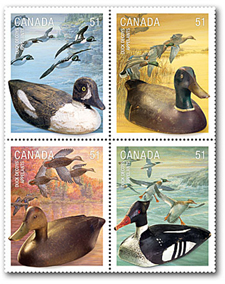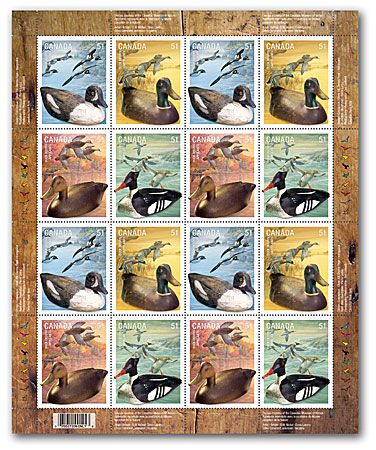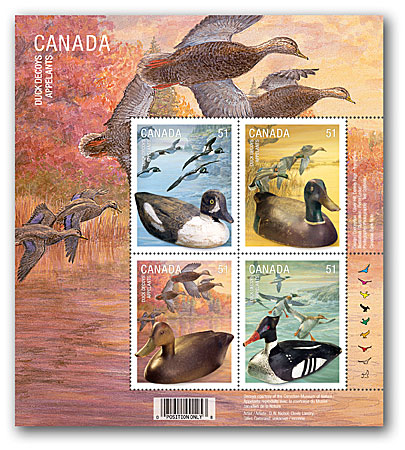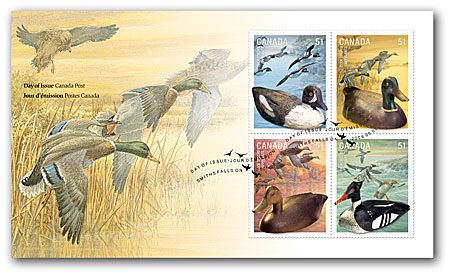Duck Decoys
August 03, 2006

From practical lures to modern-day collectibles, duck decoys are now arguably more at home on mantels than in marshes.
References to using decoys to attract birds are found in the histories of ancient Egypt, Greece and parts of post-Renaissance Europe. In North America, duck decoys have a long history as well; one of the oldest surviving decoys in North America dates back almost a thousand years.
Decoys crafted by Canadians demonstrate a wide range of carving traditions and techniques that reflect everything from local hunting practices to environmental and economic conditions to the unique artistic sensibilities of the carver.
On August 3, 2006, Canada Post will issue a set of four domestic rate (51¢) stamps to honour the history and evolution of duck decoys in Canada.
During the past century, duck decoys have evolved from a working tool of the hunt to folk art sculptures prized by collectors. As with most collectibles, the value of the item is based on a number of factors, including rarity, maker, condition, species, regional preferences, age and the uniqueness of the pose. Many of Canada's finest decoys are now part of private collections in the U.S. In 2004, a new record price was set for a Canadian-carved decoy when a collector paid $187,000 USD for a Thomas Chambers wood drake.
"The decoys chosen for this stamp issue represent four different regional species and carving styles," says Danielle Trottier, Manager of Stamp Design and Production at Canada Post. "The red-breasted merganser represents the Maritimes; the barrow's golden eye, Quebec; the black duck, Ontario; and the mallard, the Prairie region. All are authentic working decoys, many showing the scars of their labours and years."
Designed by Dennis Page and Oliver Hill of trampoline in Halifax, the stamps combine the photography of Ted Coldwell and original painting by Pierre Leduc to illustrate the decoys against an authentic backdrop. "The juxtaposition of the two media gives the visual impression that the decoy is attracting the flying ducks represented in the painting," says Page.
Inspiration for the paintings came from 1930s-era hunting-gear catalogues, as well as research into paintings of ducks and geese throughout Canada, particularly those of Allan Brooks, a renowned wildlife artist.
The help and collaboration of the Canadian Museum of Nature were invaluable in the production of this stamp issue. The four decoys featured in the stamp set are part of an archived collection at the museum.

Pane of 16 stamps
$8.16
- Product #: 403646107
- Denomination: 4 x 51¢
- Design: Oliver Hill and Dennis Page, trampoline
- Dimensions: 38 mm x 48 mm (vertical)
- Printer: Canadian Bank Note
- Printing Process: Lithography in 4 colours
- Quantity: 4,500,000
- Gum Type: P.V.A.
- Illustration: Pierre Leduc Decoys courtesy of the Canadian Museum of Nature
- Perforations: 13+
- Tagging: General, 4 sides
- Photography: Ted Coldwell
- Paper Type: Tullis Russell Coatings
- OFDC Cancellation Location: Smiths Falls, Ontario

Souvenir sheet of 4 stamps
$2.04
- Product #: 403646145
- Dimensions: 130 mm x 145 mm (vertical)
- Quantity: 400,000

Official First Day Cover
$3.04
- Product #: 403646126
- OFDC Cancellation Location: Smiths Falls, Ontario


